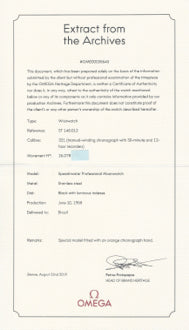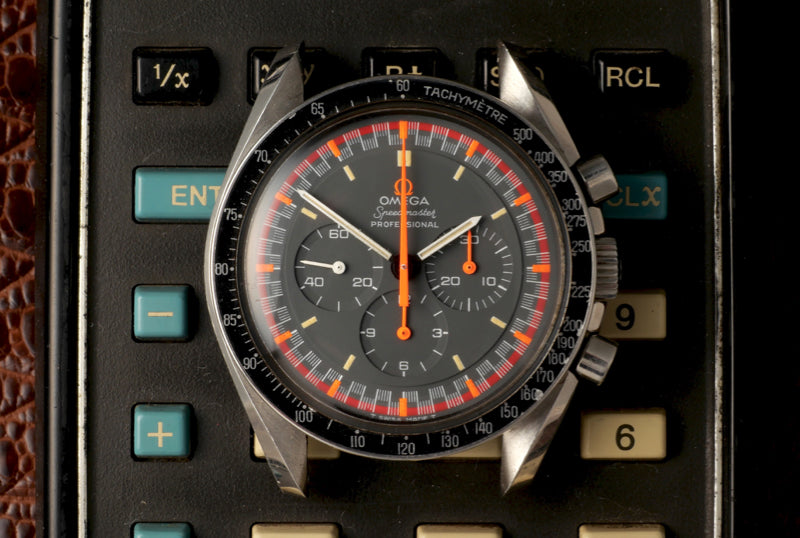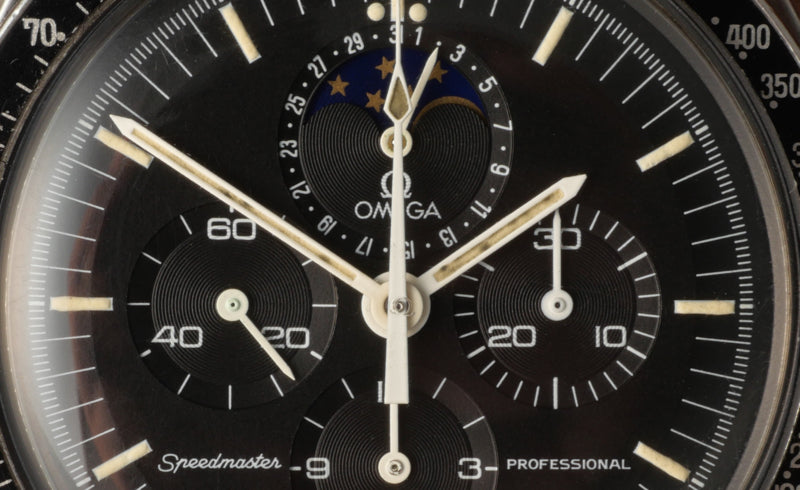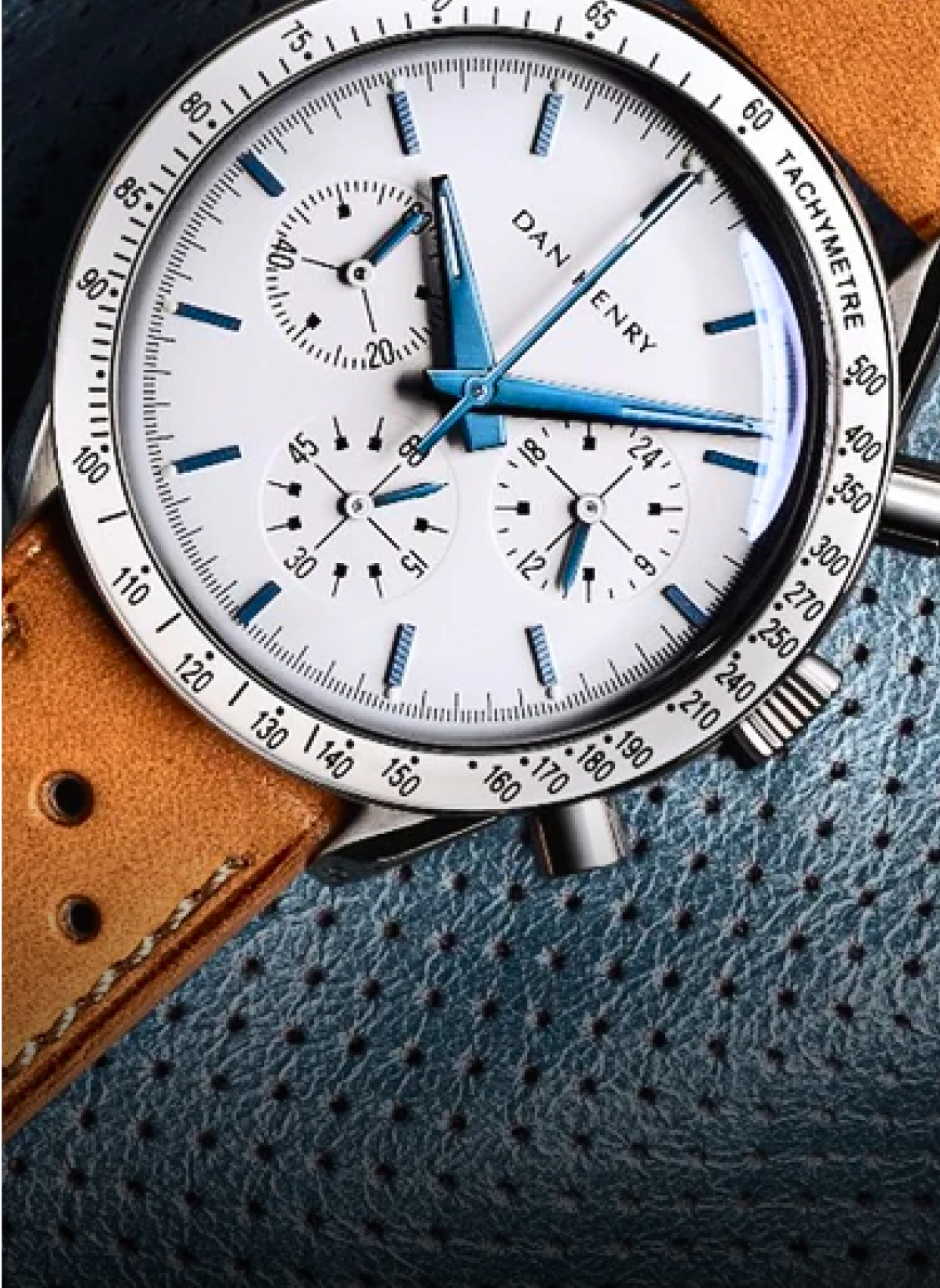How to Authenticate a Rare Omega Speedmaster
I bought a rare Omega Speedmaster MoonWatch this week, and my experience negotiating the deal and studying to authenticate the watch made me realize there are some important issues to consider as you do your research before buying an unusual watch.
Estimating a price for some of the important watches of the 1960s – in particular, the MoonWatch and the sport Rolex models of the same era - can be challenging because one of the critical issues that affects the value is how “original” the watch is. These watches are more than 50 years old, and I estimate that more than 90 percent of watches from that period this time are no longer completely original. In the collector’s market, less-than-original watches have a much lower value.
However, despite all the information available to buyers, most collectors continue to buy wrong and are often misled by unscrupulous traders into paying prices that are similar to, or even higher, than those offered by auction houses for totally original pieces. Today, collecting watches is back in fashion, and a new generation of collectors is emerging. But the lack of experience, the rush to form a collection, loose cash, and the allure of buying in a luxury market is the perfect environment for dishonest people to make easy money.
The Value is in the Details
The MoonWatch version of the Omega Speedmaster is the company’s most successful model, a timepiece that has brilliantly exploited the company’s relationship with space travel since the early 1960s. Today, even non-collectors knows that astronauts orbited the earth and walked on the moon while wearing Omega Speedmasters. Millions of Speedmasters were produced, and - especially in examples from the 1960s - small differences in models are the determining factors in the current pricing of these watches.
For a Speedmaster collection, the color of the dial, the way the numbers were engraved, and even a single hand can multiply the value of a watch by 10 or 20 times; so it is with the micro details that are used to authenticate and price a MoonWatch.
To complicate things, the MoonWatch has been manufactured virtually unchanged for more than 50 years and its parts are 100% interchangeable. As a result, the parts produced today fit perfectly in their older and rare brothers. However, when new parts are added, even though they may give the watch a fresh look, they devalue the piece to the point that experienced collectors simply are not interested in the piece for the price a full original can command. We call these watches Frankenwatches, and such watches often wind up being sold to less-experienced collectors.
"Omega Speedmaster Ultraman"
The Hunt for a Rare Speedmaster
This story started a couple of months ago. I got a WhatsUp message from a friend who collects watches, one of a group of my friends who have met years on weekends at antique fairs to hunt. His message asked: how much would a professional Speedmaster MoonWatch with the rare 321 caliber be worth? I responded him that the price can vary a lot depending on the condition and originality of the case, dial, and bezel. I asked him to send pictures.
Two minutes later, photos arrived and I was stunned; the photos showed a seemingly-normal MoonWatch but with a central chronograph hand like the Speedmaster Mark 2. So, it was possible that the piece was the very rare Speedmaster Ultraman. I alerted my friend that the watch could be an extremely rare piece, and it could be worth the risk to buy it; if original, the watch would be worth 10 times the asking price. My friend was convinced; the same day, he took a plane and went to pick up the Omega.
My Authentication Process
With the watch in hand, it was time to authenticate it. I like to say that I analyze and authenticate a watch in layers. When I check a watch, my goal is to find defects, and if I don't find any, I usually buy the watch.
In the first layer, I try to determine if the watch looks all original. I check to see that the wear on the case matches the wear on the bezel and dial, and that discoloration of the hands matches the patina of the lume. I also see if the case-back shows wear that looks similar to the case.
On the movement, I look if any parts are missing. If the movement appears to be complete, I don't care much about whether it works or not; this is the least of my considerations about a vintage watch when it's time to buy. (I have owned watches for decades that I've never fixed and will never fix; sometimes a watch is important to own, but it's not worth the risk of trying to fix it and causing even more damage. After all, if I know I won't use it, I don't need to fix, right?)
After a watch passes my first originality check, I look into the details in depth. At this stage, the important issue is to ensure that all parts of the watch were manufactured at the same time, and therefore most likely assembled together and not joined together decades later. For example, to determine when a Speedy dial was manufactured, we need to compare the smallest details, such as how the Speedmaster's “R” leg ends, or whether "Swiss Made" or “T Swiss T" is engraved under the dial.
At the Chuck Maddox website, you will find the information you need to authenticate and determine your Speedmaster's manufacturing date. You can also refer to the book MoonWatch Only from Gregoar Rossier and Anthony Marquie, which featured an even more complete source of information (the book itself is rare and expensive, but valuable for the collector of premium vintage watches). A third alternative is to submit the watch to a specialized forum and get help from those who understand it. The success of this option will depend on the goodwill of the forum participants. However, if your watch is an interesting piece, you are likely to get some attention.
 Check with the factory
Check with the factory
After all of this checking, you still need to make sure that the watch came out of the factory in the exact configuration it is in today. For example, a 1962 Omega Speedmaster is worth 10 times more than a Seamaster of the same year, even though they use exactly the same 321 caliber movement. So you need to make sure that your watch is a born Speedmaster and is not a Frankenstein Seamaster; to do this requires asking for an “Extract from the Archives” at Omega.
In the case of my Ultraman, we needed to make sure that the watch left the factory with the red MK2 hand. The factory confirmed this question and also confirmed that the watch was sold in Brazil in 1968. As a result, the investigation was complete; the watch was a 100 percent original Ultraman.
To get an Extract from Omega is easy: you just need to photograph the front and the case-back of the watch and send the serial numbers of the movement and case back to Omega on this site (link). After receiving the information, Omega will send you an invoice for CHF120 (about $120), which can be paid by credit card.
 In a few weeks, you will receive an Extract from the Archives by mail. This document will show the model of your watch, the year of manufacture, the country and year where the watch was sold, and possibly extraordinary notes. For instance, the Extract about the Ultraman included the note, "Special model fitted with an orange chronograph hand." That single sentence instantly quintupled the price of the watch; only by obtaining the certificate were we able to authenticate the piece.
In a few weeks, you will receive an Extract from the Archives by mail. This document will show the model of your watch, the year of manufacture, the country and year where the watch was sold, and possibly extraordinary notes. For instance, the Extract about the Ultraman included the note, "Special model fitted with an orange chronograph hand." That single sentence instantly quintupled the price of the watch; only by obtaining the certificate were we able to authenticate the piece.
Obtaining an Extract from the Archives usually increases the value of the watch, because only by obtaining one are you sure that your piece is 100% original, I have the Extract for almost all my most important watches.
(Note: the Extract does not authenticate some watch components such as dial, bezel, etc., so you will still need to carefully study your piece).
A little bit about the UltraMan and other Speedys
The Ultraman was manufactured only in 1968 and, has the reference 145.012-67. It is known that Speedmasters of this reference manufactured in 1968 were numbered in the serial range of 26.076.xxx to 26.079.xxx, with up to 3000 watches of this reference being manufactured in that year. But what is not known for certain is how many of these watches were manufactured with the Ultraman hand. It is estimated that fewer than 50 have been found to date and the only way to authenticate them is with the Extract from the Archives.
Interestingly, the nickname Ultraman came up when the watch appeared in the "Return of Ultraman" television series of 1971-72. This model was re-launched in 2018 and as a result, the prices for the original prices jumped; the last auction of an Ultraman reached USD 76.250, but I think the price may have been inflated to promote this auction that I wrote about it in the article, “Who is causing the price explosion for vintage watches?”
The picture in this article shows the three other rare Speedmasters that also needed Extracts from the Archives to be fully authenticated.
Of my four Speedmasters, the piece with the grey racing dial is the rarest; only a dozen of these watches have been found. It was sold exclusively in Switzerland in 1970; it is not known why the Speedmaster with racing dial was offered for sale and then soon taken out of stores. This model is considered original only with an Extract from the Archives, because many were later assembled with spare parts that were not withdrawn from the market. This watch was re-launched in 2004 in an edition made exclusively for Japan.

The Speedmaster Moon Phase is from 1985, the first Speedmaster that shows the phases of the moon. Only 1300 of them were made. I am obsessed with moon phases and this watch was one of my dreams until I found it in Portugal. Mine is an original and confirmed by the Omega Archives, but there are many pieces available that were assembled from spare parts.

The Speedmaster case-back was made to commemorate the walk on the moon by Neil Armstrong and Buzz Aldrin in July 1969. The engraved Hippocampus (seahorse) was removed and the phrases “The first watch worn on the moon” and “Flight qualified by NASA for all manned space missions” were engraved. The arrangement of the text was then changed in 1971 to incorporate the Hippocampus on the back as well. If you find a Speedy with this case-back, it is important to request the Omega Extract, because it is easy to find pieces with fake case-backs.
It is common to find “Omegas” that are created by suppliers who use a mix of used, counterfeit, and original parts. The most notorious of these companies is a former Omega authorized dealer known as WatchCo. If you have bought an Omega from the 1960s or 1970s in new old stock condition during the last 15 years, the chances are good that it was created by WatchCo. This is a subject I will cover in my next article.







 Check with the factory
Check with the factory

